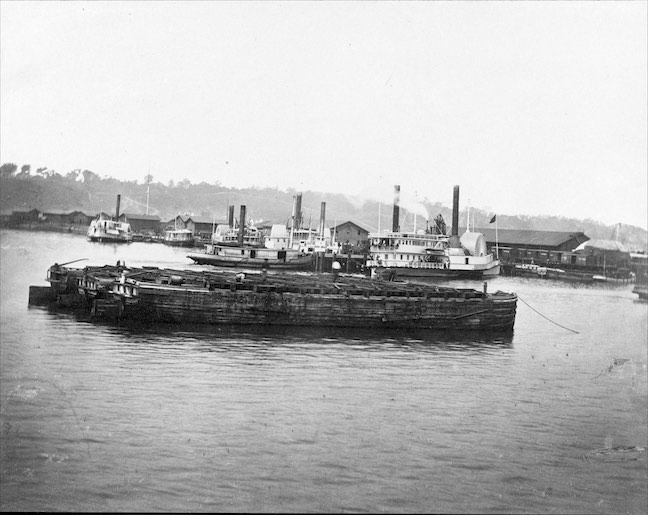| Credit: | by OSullivan (Timothy H.) |
|---|---|
| Date: | 1863.02 |
| Negative Size: | 8 in. x 10 in. |
| Locations & Lines: | Aquia Creek & Fredericksburg Railroad (AC&F); Aquia Creek Landing VA; Potomac River; Virginia |
| Military Units: | US Military Railroads (USMRR); US Army |
| Transports: | barge; boxcar; side-wheeler; tugboat |
| Sources: | Library of Congress; National Archives |
$6.99
File Details: AIKOm, 800 DPI, TIFF, Original Photograph, 39.9 Mb
Image ID: AIKO
Though Gardner dates this as June of 1863, it was more likely shot in February of that year, when O’Sullivan and Gardner visited the location.
Gardners Photographic Sketch Book Of The War. Vol. 1, No. 33. Evacuation of Aquia Creek. June, 1863. This sketch was taken a few hours previous to the abandonment of Aquia Creek in June, 1863. The Army of the Potomac was along the Rappanannock before Fredericksburg, fifteen miles distant, and had used this point and Belle Plain, a similar landing, seven miles below, as a base of supplies. The movement commenced on Saturday morning. The President was expected to visited [sic] the army on that day, but the advance of the Confederate into Pennsylvania admitting of no delay, Gen. Hooker, in the afternoon, telegraphed Mr. Lincoln not to come, and immediately made preparations to leave. At daylight, Sunday morning, the whole army was in motion, and an immense throng of sutlers and other camp followers collected at Aquia Creek for transportation to Washington. By 10 A. M. the camps between this point and Fredericksburg were all deserted, and the civilians, in constant apprehension of an attack from the Confederate cavalry that might follow up the army as it passed the landing on its march to Washington, crowded on to the boats in the greatest confusion. The steamers were already heavily laden with stores, wagons, &c., and the evacuation was attended with scenes that would have been regarded as ridiculous but for the general alarm. The barges anchored in the stream were locked together for the transportation of the cars on the wharf, and were towed to Washington by the steamers loaded with passengers. All of the supplies had been removed from the buildings, and the latter, erected at great expense by the Quartermasters Department, were committed to the flames. A gunboat lay out in the river for the protection of the place until all could get away; but no enemy appeared, and in a short time nothing remained of the busy village but smoking embers and half-burned wharves. Aquia Creek has been used three times as a base of supplies; once for McDowell, in 1862; next for Burnside, after the Antietam Campaign; and finally during Grants operations at Spottsylvania. Nearly a hundred steamers have been collected here at one time, while sailing vessels anchored in the river nearly obstructed its navigation. The wounded were brought here from Fredericksburg, Chancellorsville, Wilderness, and Spottsylvania, to be sent to Washington; and in nearly all of the operations of the army in Eastern Virginia the place has borne a conspicuous part. The Confederates had formidable batteries on the bluffs which commanded the river previous to our occupation of Fredericksburg in the spring of 1862, and at the same time sheltered in the stream that runs down between the hills, the notorious iron-clad Page.
The landing is now used by the Washington, Fredericksburg and Richmond Railroad Company, but will probably never be more than an ordinary station. Fever and ague prevail during the summer, forbidding the growth of a village, and with the completion of the railroad to Alexandria, the place will doubtless sink into oblivion, except as connected with the military operations of the great rebellion.

